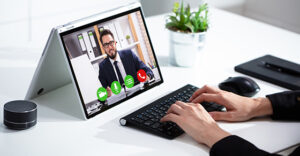
Although remote audit procedures can streamline the audit process and minimize health risks, to accurately identify and assess the risk of fraud during an audit of financial statements, it’s important to be able to see somebody’s face. The solution to this conundrum may lie in remote meetings using videoconferencing technology.
Questions Matter
Auditors must assess the risk of misstatement due to fraud and determine how to respond to those risks. Specific areas of inquiry under Clarified Statement on Auditing Standards (AU-C) Section 240, Consideration of Fraud in a Financial Statement Audit include:
- Whether management has knowledge of any actual, suspected or alleged fraud
- Management’s process for identifying, responding to and monitoring the fraud risks in the entity
- The nature, extent and frequency of management’s assessment of fraud risks and the results of those assessments
- Any specific fraud risks that management has identified or that have been brought to its attention AND
- The classes of transactions, account balances or disclosures for which a fraud risk is likely to exist.
Auditors will also inquire about managers’ communications with the people in charge of overseeing the management team’s fraud prevention strategies as well as their communication with employees about ethical business practices and avoiding fraud.
Faces-to-face matters
Nonverbal signals are an important part of assessing the truthfulness of a speaker’s statements, which is why auditors typically require in-person meetings with managers. Visible signs of stress are clues that the interviewee has something to hide.
Due to the COVID-19 pandemic, many people are avoiding face-to-face meetings, particularly if they or somebody in their household is considered high risk. Face masks also present a challenge from an audit perspective because they muffle speech and disguise facial expressions.
Both of these issues can be addressed by a teleconference. Although some people still prefer the familiar technology of a phone call, videoconference tools can preserve the in-person benefits of an in-person interview without exposing either party to health risks. Modern videoconferencing technology is high-definition enough that auditors can detect cues such as raised eyebrows, eye rolls, and furrowed brows, which can help auditors assess an interviewee’s reliability.
Mitigating Risks
Fraud evaluation is one of an auditor’s most critical responsibilities. In advance of a meeting, prepare your managers by briefing them on the types of questions you expect an auditor to ask and by being sure that they are familiar with how to use video conferencing technology.
For more information, contact your trusted Smolin professional.
